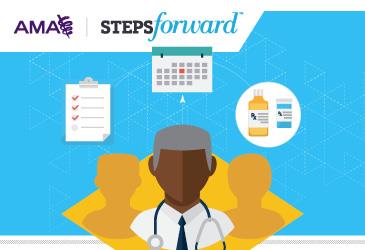Practices across the country have been implementing team-based care models to make better use of the skills and training of the care team and streamline office procedures, but what does this type of care model entail? Find out what a highly-functional team-based patient visit could look like from before the patient arrives through checkout.
The AMA’s STEPS Forward™ collection of practice improvement strategies can help your practice implement team-based care. The module details the individual elements of a team-based care model and shows you how to bring all of those elements together.
Effective pre-visit activities
One of the cornerstones of team-based care is making sure that your patients and team are prepared for patient visits ahead of time. The most efficient method is to plan ahead for the next visit at the conclusion of the present visit—remember: The next appointment starts today. In addition, a designated nurse, medical assistant (MA) or other team member can complete the pre-visit planning activities just prior to the appointment.
Conduct pre-visit planning two to three days prior to the patient visit:
- Review notes from the previous visit. The designated team member ensures that follow-up results are available for physician review.
- Use a registry or visit-prep checklist. The checklist helps to identify any care gaps or upcoming preventive and chronic care needs.
- Identify whether any further information is required for the visit. This could include hospital discharge notes, emergency department notes or operative notes from a recent surgery.
- Send automated appointment reminders to patients. This could include accurate check-in time and accounting for the additional time it will take to complete any necessary paperwork. Use the pre-visit questionnaire to streamline the information gathering process.
- Order pre-visit labs at the end of each appointment. Ordering the labs ahead of time allows them to be completed prior to the next appointment using the visit planner checklist.
- Start the day with a team huddle. Gathering together at the beginning of the day can prepare the team by reviewing the schedule and discussing important items that are pertinent to all team members.
The patient visit
In team-based care, the patient visit follows a structure that uses the expertise of individuals on the team to streamline the process. First, the nurse or MA updates the medical record, closes care gaps and obtains an initial history. When the physician joins the appointment, the nurse, MA or documentation specialist helps document the visit. At the end of the visit, that team member then emphasizes the plan of care and conducts motivational interviewing and education with the patient.
Using this care model, the nurses or MAs become more knowledgeable about the treatment plan, can more effectively coordinate care between visits, and develop closer independent relationships with patients and their families.
To aid in this process, practices can:
- Expand rooming and discharge protocols. This can leverage the skills and training of staff to perform additional tasks and responsibilities associated with a patient visit to allow physicians more time to interact with patients. You can use the rooming checklist to guide this process.
- Implement team documentation to further streamline the patient visit. A clinical or clerical assistant accompanies the physician in the exam room with the patient and helps document all patient visits, expanding the time the physician has to connect with patients and easing electronic health record woes.
- Use the annual visit to synchronize prescription renewals. The physician can indicate which chronic medications may be refilled for the entire year and which to modify or discontinue. This can reduce the number of calls and amount of work that comes with frequent renewal requests. Once the physician portion of the visit is complete, the physician can exit the room, review the notes, make any modifications and sign the note. Now, the physician is ready to transition to the next patient’s room.
- Use the end of the visit to plan the next visit. Planning for the next visit should occur at the conclusion of each visit. The visit planner checklist can help by clarifying the upcoming appointments and the laboratory and diagnostic work that should be completed before the patient returns. The patient should leave the visit with a sense of commitment and support from the care team.
More than 25 modules are available in the AMA’s STEPS Forward collection, and several more will be added later this year, thanks to a grant from and collaboration with the Transforming Clinical Practices Initiative.




